Improving the Accuracy of Groundwater Storage Estimates Based on Groundwater Weighted Fusion Model
Abstract
:1. Introduction
2. Materials and Methods
2.1. Study Area
2.2. Materials
2.2.1. GRACE Data
2.2.2. Soil Moisture Datasets
2.2.3. Groundwater Level from Wells
2.2.4. Auxiliary Data
2.3. Methods
2.3.1. Construction of GWFM
2.3.2. Estimation of GWSA Based on GRACE
2.3.3. Multiple Linear Regression of Time Series
2.3.4. Estimation of the Contribution to GWS
2.3.5. Evaluation Index
3. Results
3.1. Experimental Verifications of the GWFM
3.2. Comparison of GWSA
3.3. Spatial Pattern of Variation Trends in GWSA
3.4. Response of GWSA to Climate Change
3.5. Response of GWSA to Human Factors
4. Discussion
4.1. Spatial Distribution of Weight Index
4.2. Contributions of Different Factors to GWS
4.3. Limitation and Furture Work
5. Conclusions
- (1)
- To obtain an accurate estimation of GWSA, this paper proposes a groundwater weighted fusion model. A comprehensive example is defined to verify the performance of the GWFM, and the superiority of the GWFM is verified by in situ groundwater-level measurements. The results show that the GWFM can effectively integrate the advantages of each data set sand produce a more reliable GWSA than the original results. Compared with GRACE-based GWSA, GWFM-based GWSA can obtain higher CC and NSE, CC increases by 9–40%, NSE increases by 23–657%, while RMSE decreases by 9–28%.
- (2)
- The GWSA result of the HC from 2003 to 2016 is calculated based on the GWFM. GWFM-based GWSA show an overall downward trend from 2003 to 2016, but 2011 is a turning point. From 2003 to 2010, there is a rapid downward trend, which is −2.37 ± 0.38 mm/yr, while the downward trend from 2011 to 2016 is significantly slowed, at −0.46 ± 1.35 mm/yr. This may be related to the local implementation of corresponding water-saving policies. In terms of spatial changes, in the central and southern part of the SLRB, the central part of the HRB and the northern part of the SYRB, which are the main GWS depleted areas, have a large downward trend. Furthermore, GWFM-based GWSA can better retain the characteristics of regional GWSA relative to the arithmetic average result, especially in the southeast of the SYRB.
- (3)
- A simple and effective method is used to evaluate the contribution of climate factors and human factors to GWS. The results show that the amount of groundwater withdrawal has a significant impact on GWS, especially in the HRB, where the amount of groundwater withdrawal is increasing every year. As for the HC, the effects of climate change on GWS changes account for ~48%, while those of human activities contributed ~52%. In general, human activities, especially agricultural irrigation, have become the main reason for GWS decline in the HC.
Author Contributions
Funding
Institutional Review Board Statement
Informed Consent Statement
Data Availability Statement
Acknowledgments
Conflicts of Interest
Abbreviations
| Acronym | Full Name |
| GRACE | Gravity Recovery and Climate Experiment |
| TWS | terrestrial water storage |
| GWS | groundwater storage |
| GWSA | groundwater storage anomalies |
| GWFM | groundwater weighted fusion model |
| ETC | extended triple collocation |
| HC | Hexi Corridor |
| SYRB | Shiyang River Basin |
| HRB | Hei River Basin |
| SLRB | Shule River Basin |
| SM | soil moisture |
| SWE | snow water equivalent |
| CWS | canopy water storage |
| GLDAS | Global Land Data Assimilation System |
| WGHM | WaterGAP Global Hydrology model |
| CIGEM | China Institute of Geological Environment Monitoring |
| CC | correlation coefficient |
| RMSE | root mean squared error |
| NSE | Nash-Sutcliffe efficiency coefficient |
References
- Feng, W.; Zhong, M.; Lemoine, J.M.; Biancale, R.; Hsu, H.T.; Xia, J. Evaluation of groundwater depletion in North China using the Gravity Recovery and Climate Experiment (GRACE) data and ground-based measurements. Water Resour. Res. 2013, 49, 2110–2118. [Google Scholar] [CrossRef]
- Zhong, Y.; Zhong, M.; Mao, Y.; Ji, B. Evaluation of Evapotranspiration for Exorheic Catchments of China during the GRACE Era: From a Water Balance Perspective. Remote Sens. 2020, 12, 511. [Google Scholar] [CrossRef] [Green Version]
- Eamus, D.; Zolfaghar, S.; Villalobos Vega, R.; Cleverly, J.; Huete, A. Groundwater-dependent ecosystems: Recent insights from satellite and field-based studies. Hydrol. Earth Syst. Sci. 2015, 19, 4229–4256. [Google Scholar] [CrossRef] [Green Version]
- Frappart, F.; Ramillien, G. Monitoring groundwater storage changes using the Gravity Recovery and Climate Experiment (GRACE) Satellite Mission: A Review. Remote Sens. 2018, 10, 829. [Google Scholar] [CrossRef] [Green Version]
- Wang, S.; Liu, H.; Yu, Y.; Zhao, W.; Yang, Q.; Liu, J. Evaluation of groundwater sustainability in the arid Hexi Corridor of Northwestern China, using GRACE, GLDAS and measured groundwater data products. Sci. Total Environ. 2020, 705, 135829. [Google Scholar] [CrossRef]
- Chen, J.; Famigliett, J.S.; Scanlon, B.R.; Rodell, M. Groundwater Storage Changes: Present Status from GRACE Observations. Surv. Geophys. 2016, 37, 397–417. [Google Scholar] [CrossRef]
- Yin, W.; Li, T.; Zheng, W.; Hu, L.; Han, S.C.; Tangdamrongsub, N.; Šprlák, M.; Huang, Z. Improving regional groundwater storage estimates from GRACE and global hydrological models over Tasmania, Australia. Hydrogeol. J. 2020, 28, 1809–1825. [Google Scholar] [CrossRef]
- Tapley, B.D.; Bettadpur, S.; Ries, J.C.; Thompson, P.F.; Watkins, M.M. GRACE measurements of mass variability in the earth system. Science 2004, 305, 503–505. [Google Scholar] [CrossRef] [Green Version]
- Rodell, M.; Velicogna, I.; Famiglietti, J.S. Satellite-based estimates of groundwater depletion in India. Nature 2009, 460, 999–1002. [Google Scholar] [CrossRef] [Green Version]
- Rodell, M.; Famiglietti, J.S. An analysis of terrestrial water storage variations in Illinois with implications for the Gravity Recovery and Climate Experiment (GRACE). Water Resour. Res. 2001, 37, 1327–1339. [Google Scholar] [CrossRef] [Green Version]
- Chen, H.; Zhang, W.; Nie, N.; Guo, Y. Long-term groundwater storage variations estimated in the Songhua River Basin by using GRACE products, land surface models, and in-situ observations. Sci. Total Environ. 2019, 649, 372–387. [Google Scholar] [CrossRef]
- Tangdamrongsub, N.; Han, S.C.; Decker, M.; Yeo, I.Y.; Kim, H. On the use of the GRACE normal equation of inter-satellite tracking data for estimation of soil moisture and groundwater in Australia. Hydrol. Earth Syst. Sci. 2018, 22, 1811–1829. [Google Scholar] [CrossRef] [Green Version]
- Rodell, M.; Houser, P.R.; Jambor, U.; Gottschalck, J.; Mitchell, K.; Meng, C.J.; Arsenault, K.; Cosgrove, B.; Radakovich, J.; Bosilovich, M.; et al. The global land data assimilation system. Bull. Am. Meteorol. Soc. 2004, 85, 381–394. [Google Scholar] [CrossRef] [Green Version]
- Döll, P.; Kaspar, F.; Lehner, B. A global hydrological model for deriving water availability indicators: Model tuning and validation. J. Hydrol. 2003, 270, 105–134. [Google Scholar] [CrossRef]
- Xu, L.; Chen, N.; Zhang, X.; Moradkhani, H.; Zhang, C.; Hu, C. In-situ and triple-collocation based evaluations of eight global root zone soil moisture products. Remote Sens. Environ. 2021, 254, 112248. [Google Scholar] [CrossRef]
- Hersbach, H.; Bell, B.; Berrisford, P.; Hirahara, S.; Horányi, A.; Muñoz-Sabater, J.; Nicolas, J.; Peubey, C.; Radu, R.; Schepers, D.; et al. The ERA5 global reanalysis. Q. J. R. Meteorol. Soc. 2020, 146, 1999–2049. [Google Scholar] [CrossRef]
- Scanlon, B.R.; Longuevergne, L.; Long, D. Ground referencing GRACE satellite estimates of groundwater storage changes in the California Central Valley, USA. Water Resour. Res. 2012, 48, 4520. [Google Scholar] [CrossRef] [Green Version]
- Famiglietti, J.; Lo, M.; Ho, S.; Bethune, J.; Anderson, K.; Syed, T.; Swenson, S.; De Linage, C.; Rodell, M. Satellites Measure Recent Rates of Groundwater Depletion in California’s Central Valley. Geophys. Res. Lett. 2011, 38. [Google Scholar] [CrossRef] [Green Version]
- Long, D.; Chen, X.; Scanlon, B.R.; Wada, Y.; Hong, Y.; Singh, V.P.; Chen, Y.; Wang, C.; Han, Z.; Yang, W. Have GRACE satellites overestimated groundwater depletion in the Northwest India Aquifer? Sci. Rep. 2016, 6, 24398. [Google Scholar] [CrossRef]
- Bhanja, S.N.; Mukherjee, A.; Saha, D.; Velicogna, I.; Famiglietti, J.S. Validation of GRACE based groundwater storage anomaly using in-situ groundwater level measurements in India. J. Hydrol. 2016, 543, 729–738. [Google Scholar] [CrossRef]
- Huang, Z.; Pan, Y.; Gong, H.; Yeh, P.J.F.; Li, X.; Zhou, D.; Zhao, W. Subregional-scale groundwater depletion detected by GRACE for both shallow and deep aquifers in North China Plain. Geophys. Res. Lett. 2015, 42, 1791–1799. [Google Scholar] [CrossRef]
- Moiwo, J.P.; Tao, F.; Lu, W. Analysis of satellite-based and in situ hydro-climatic data depicts water storage depletion in North China Region. Hydrol. Process. 2013, 27, 1011–1020. [Google Scholar] [CrossRef]
- Agutu, N.O.; Awange, J.L.; Ndehedehe, C.; Kirimi, F.; Kuhn, M. GRACE-derived groundwater changes over Greater Horn of Africa: Temporal variability and the potential for irrigated agriculture. Sci. Total Environ. 2019, 693, 133467. [Google Scholar] [CrossRef]
- Hu, Z.; Zhou, Q.; Chen, X.; Chen, D.; Li, J.; Guo, M.; Yin, G.; Duan, Z. Groundwater Depletion Estimated from GRACE: A Challenge of Sustainable Development in an Arid Region of Central Asia. Remote Sens. 2019, 11, 1908. [Google Scholar] [CrossRef] [Green Version]
- Xiao, R.; He, X.; Zhang, Y.; Ferreira, V.G.; Chang, L. Monitoring Groundwater Variations from Satellite Gravimetry and Hydrological Models: A Comparison with in-situ Measurements in the Mid-Atlantic Region of the United States. Remote Sens. 2015, 7, 686–703. [Google Scholar] [CrossRef] [Green Version]
- Duan, Q.; Ajami, N.K.; Gao, X.; Sorooshian, S. Multi-model ensemble hydrologic prediction using Bayesian model averaging. Adv. Water Resour. 2007, 30, 1371–1386. [Google Scholar] [CrossRef] [Green Version]
- Mehrnegar, N.; Jones, O.; Singer, M.B.; Schumacher, M.; Bates, P.; Forootan, E. Comparing global hydrological models and combining them with GRACE by dynamic model data averaging (DMDA). Adv. Water Resour. 2020, 138, 103528. [Google Scholar] [CrossRef]
- van Dijk, A.; Renzullo, L.; Wada, Y.; Tregoning, P. A global water cycle reanalysis (2003–2012) merging satellite gravimetry and altimetry observations with a hydrological multi-model ensemble. Hydrol. Earth Syst. Sci. 2014, 18, 2955–2973. [Google Scholar] [CrossRef] [Green Version]
- Soltani, S.S.; Ataie-Ashtiani, B.; Simmons, C.T. Review of assimilating GRACE terrestrial water storage data into hydrological models: Advances, challenges and opportunities. Earth-Sci. Rev. 2021, 213, 103487. [Google Scholar] [CrossRef]
- Dumedah, G.; Walker, J.P. Assessment of land surface model uncertainty: A crucial step towards the identification of model weaknesses. J. Hydrol. 2014, 519, 1474–1484. [Google Scholar] [CrossRef]
- Tangdamrongsub, N.; Han, S.-C.; Yeo, I.-Y.; Dong, J.; Steele-Dunne, S.C.; Willgoose, G.; Walker, J.P. Multivariate data assimilation of GRACE, SMOS, SMAP measurements for improved regional soil moisture and groundwater storage estimates. Adv. Water Resour. 2020, 135, 103477. [Google Scholar] [CrossRef]
- Shamseldin, A.Y.; O’Connor, K.M.; Liang, G.C. Methods for combining the outputs of different rainfall–runoff models. J. Hydrol. 1997, 197, 203–229. [Google Scholar] [CrossRef]
- Long, D.; Pan, Y.; Zhou, J.; Chen, Y.; Hou, X.; Hong, Y.; Scanlon, B.R.; Longuevergne, L. Global analysis of spatiotemporal variability in merged total water storage changes using multiple GRACE products and global hydrological models. Remote Sens. Environ. 2017, 192, 198–216. [Google Scholar] [CrossRef]
- Shamseldin, A.Y.; O’Connor, K.M. A real-time combination method for the outputs of different rainfall-runoff models. Hydrol. Sci. J. 1999, 44, 895–912. [Google Scholar] [CrossRef]
- Gruber, A.; Su, C.H.; Zwieback, S.; Crow, W.; Dorigo, W.; Wagner, W. Recent advances in (soil moisture) triple collocation analysis. Int. J. Appl. Earth Obs. Geoinf. 2016, 45, 200–211. [Google Scholar] [CrossRef]
- Rusli, S.R.; Weerts, A.H.; Taufiq, A.; Bense, V.F. Estimating water balance components and their uncertainty bounds in highly groundwater-dependent and data-scarce area: An example for the Upper Citarum basin. J. Hydrol. Reg. Stud. 2021, 37, 100911. [Google Scholar] [CrossRef]
- Khaki, M.; Awange, J.; Forootan, E.; Kuhn, M. Understanding the association between climate variability and the Nile’s water level fluctuations and water storage changes during 1992–2016. Sci. Total Environ. 2018, 645, 1509–1521. [Google Scholar] [CrossRef] [Green Version]
- Nigatu, Z.M.; Fan, D.; You, W. GRACE products and land surface models for estimating the changes in key water storage components in the Nile River Basin. Adv. Space Res. 2021, 67, 1896–1913. [Google Scholar] [CrossRef]
- Yin, G.; Park, J. The use of triple collocation approach to merge satellite- and model-based terrestrial water storage for flood potential analysis. J. Hydrol. 2021, 127197. [Google Scholar] [CrossRef]
- McColl, K.A.; Vogelzang, J.; Konings, A.G.; Entekhabi, D.; Piles, M.; Stoffelen, A. Extended triple collocation: Estimating errors and correlation coefficients with respect to an unknown target. Geophys. Res. Lett. 2014, 41, 6229–6236. [Google Scholar] [CrossRef] [Green Version]
- Li, X.; Tong, L.; Niu, J.; Kang, S.; Du, T.; Li, S.; Ding, R. Spatio-temporal distribution of irrigation water productivity and its driving factors for cereal crops in Hexi Corridor, Northwest China. Agric. Water Manag. 2017, 179, 55–63. [Google Scholar] [CrossRef]
- Wang, L.; Dong, Y.; Xu, Z. A synthesis of hydrochemistry with an integrated conceptual model for groundwater in the Hexi Corridor, northwestern China. J. Asian Earth Sci. 2017, 146, 20–29. [Google Scholar] [CrossRef]
- Chang, G.; Wang, L.; Meng, L.; Zhang, W. Farmers’ attitudes toward mandatory water-saving policies: A case study in two basins in northwest China. J. Environ. Manag. 2016, 181, 455–464. [Google Scholar] [CrossRef]
- Liu, X.; Hu, L.; Sun, K.; Yang, Z.; Sun, J.; Yin, W. Improved Understanding of Groundwater Storage Changes under the Influence of River Basin Governance in Northwestern China Using GRACE Data. Remote Sens. 2021, 13, 2672. [Google Scholar] [CrossRef]
- Hao, Y.; Xie, Y.; Ma, J.; Zhang, W. The critical role of local policy effects in arid watershed groundwater resources sustainability: A case study in the Minqin oasis, China. Sci. Total Environ. 2017, 601–602, 1084–1096. [Google Scholar] [CrossRef]
- Stoffelen, A. Toward the true near-surface wind speed: Error modeling and calibration using triple collocation. J. Geophys. Res. Ocean. 1998, 103, 7755–7766. [Google Scholar] [CrossRef]
- Guan, Q.; Yang, L.; Pan, N.; Lin, J.; Xu, C.; Wang, F.; Liu, Z. Greening and Browning of the Hexi Corridor in Northwest China: Spatial Patterns and Responses to Climatic Variability and Anthropogenic Drivers. Remote Sens. 2018, 10, 1270. [Google Scholar] [CrossRef] [Green Version]
- Fu, J.; Niu, J.; Kang, S.; Adeloye, A.J.; Du, T. Crop production in the Hexi Corridor challenged by future climate change. J. Hydrol. 2019, 579, 124197. [Google Scholar] [CrossRef]
- Bao, C.; Fang, C. Water resources constraint force on urbanization in water deficient regions: A case study of the Hexi Corridor, arid area of NW China. Ecol. Econ. 2007, 62, 508–517. [Google Scholar] [CrossRef]
- Ji, X.; Kang, E.; Chen, R.; Zhao, W.; Zhang, Z.; Jin, B. The impact of the development of water resources on environment in arid inland river basins of Hexi region, Northwestern China. Environ. Geol. 2006, 50, 793–801. [Google Scholar] [CrossRef]
- Yang, L.; Feng, Q.; Adamowski, J.F.; Deo, R.C.; Yin, Z.; Wen, X.; Tang, X.; Wu, M. Causality of climate, food production and conflict over the last two millennia in the Hexi Corridor, China. Sci. Total Environ. 2020, 713, 136587. [Google Scholar] [CrossRef]
- Save, H.; Bettadpur, S.; Tapley, B. High resolution CSR GRACE RL05 mascons. J. Geophys. Res. Solid Earth 2016, 121, 7547–7569. [Google Scholar] [CrossRef]
- Save, H.; Bettadpur, S.; Tapley, B. Reducing errors in the GRACE gravity solutions using regularization. J. Geod. 2012, 86, 695–711. [Google Scholar] [CrossRef]
- Scanlon, B.R.; Zhang, Z.; Save, H.; Wiese, D.N.; Landerer, F.W.; Long, D.; Longuevergne, L.; Chen, J. Global evaluation of new GRACE mascon products for hydrologic applications. Water Resour. Res. 2016, 52, 9412–9429. [Google Scholar] [CrossRef]
- Güntner, A.; Stuck, J.; Werth, S.; Doell, P.; Verzano, K.; Merz, B. A global analysis of temporal and spatial variations in continental water storage. Water Resour. Res. 2007, 43, 687–696. [Google Scholar] [CrossRef]
- Muñoz Sabater, J. ERA5-Land Monthly Averaged Data from 1981 to Present. Copernicus Climate Change Service (C3S) Climate Data Store (CDS). Available online: https://doi.org/10.24381/cds.68d2bb3 (accessed on 1 July 2021).
- Hutchinson, M.F. Interpolation of rainfall data with thin plate smoothing splines-Part I: Two dimensional smoothing of data with short range correlation. J. Geogr. Inf. Decis. Anal. 1998, 2, 139–151. [Google Scholar]
- Rodell, M.; Chao, B.F.; Au, A.Y.; Kimball, J.S.; McDonald, K.C. Global biomass variation and Its geodynamic effects: 1982–98. Earth Interact. 2005, 9, 1–19. [Google Scholar] [CrossRef] [Green Version]
- Strassberg, G.; Scanlon, B.R.; Chambers, D. Evaluation of groundwater storage monitoring with the GRACE satellite: Case study of the High Plains aquifer, central United States. Water Resour. Res. 2009, 45, W05410. [Google Scholar] [CrossRef] [Green Version]
- Yang, P.; Xia, J.; Zhan, C.; Qiao, Y.; Wang, Y. Monitoring the spatio-temporal changes of terrestrial water storage using GRACE data in the Tarim River basin between 2002 and 2015. Sci. Total Environ. 2017, 595, 218–228. [Google Scholar] [CrossRef]
- Xie, J.; Xu, Y.; Wang, Y.; Gu, H.; Wang, F.; Pan, S. Influences of climatic variability and human activities on terrestrial water storage variations across the Yellow River basin in the recent decade. J. Hydrol. 2019, 579, 124218. [Google Scholar] [CrossRef]
- Abhishek; Kinouchi, T. Synergetic application of GRACE gravity data, global hydrological model, and in-situ observations to quantify water storage dynamics over Peninsular India during 2002–2017. J. Hydrol. 2021, 596, 126069. [Google Scholar] [CrossRef]
- Moriasi, D.N.; Arnold, J.G.; Van Liew, M.W.; Bingner, R.L.; Harmel, R.D.; Veith, T.L. Model evaluation guidelines for systematic Quantification of Accuracy in watershed simulations. Trans. ASABE 2007, 50, 885–900. [Google Scholar] [CrossRef]
- Thomas, B.; Famiglietti, J.; Landerer, F.; Wiese, D.; Molotch, N.; Argus, D. GRACE groundwater drought index: Evaluation of California Central Valley groundwater drought. Remote Sens. Environ. 2017, 198, 384–392. [Google Scholar] [CrossRef]
- Abou Zaki, N.; Torabi Haghighi, A.; Rossi, P.; Tourian, M.; Klöve, B. Monitoring groundwater storage depletion using Gravity Recovery and Climate Experiment (GRACE) data in Bakhtegan Catchment, Iran. Water 2019, 11, 1456. [Google Scholar] [CrossRef] [Green Version]
- Yang, B.; Qin, C.; Bräuning, A.; Burchardt, I.; Liu, J. Rainfall history for the Hexi Corridor in the Arid Northwest China during the past 620 years derived from tree rings. Int. J. Climatol. 2011, 31, 1166–1176. [Google Scholar] [CrossRef]
- Zhang, S.; Zhang, Q.; Liu, Z.; Gao, Z.; Qi, D. Practice and exploration of implementing the strictest water resources management system in Gansu Province. China Water Conserv. 2011, 09, 35–37. (In Chinese) [Google Scholar]
- Su, Y.; Guo, B.; Zhou, Z.; Zhong, Y.; Min, L. Spatio-temporal variations in groundwater revealed by GRACE and Its driving factors in the Huang-Huai-Hai Plain, China. Sensors 2020, 20, 922. [Google Scholar] [CrossRef] [Green Version]
- Ding, H.; Zhang, J.; Lv, Z.; Yang, K.; Li, J.; Niu, X. Characteristics and Cycle Conversion of Water Resources in the Hexi Corridor. Arid Zone Res. 2006, 02, 241–248. (In Chinese) [Google Scholar]
- Liu, M.; Jiang, Y.; Xu, X.; Huang, Q.; Huo, Z.; Huang, G. Long-term groundwater dynamics affected by intense agricultural activities in oasis areas of arid inland river basins, Northwest China. Agric. Water Manag. 2018, 203, 37–52. [Google Scholar] [CrossRef]
- Byrne, M.P.; O’Gorman, P.A. The response of precipitation minus evapotranspiration to climate warming: Why the “Wet-Get-Wetter, Dry-Get-Drier” scaling does not hold over land. J. Clim. 2015, 28, 8078–8092. [Google Scholar] [CrossRef]
- Buma, W.; Lee, S.I. Multispectral image-based estimation of drought patterns and intensity around Lake Chad, Africa. Remote Sens. 2019, 11, 2534. [Google Scholar] [CrossRef] [Green Version]
- Barnett, T.P.; Adam, J.C.; Lettenmaier, D.P. Potential impacts of a warming climate on water availability in snow-dominated regions. Nature 2005, 438, 303–309. [Google Scholar] [CrossRef]
- Wang, Y.; Qin, D. Influence of climate change and human activity on water resources in arid region of Northwest China: An overview. Adv. Clim. Change Res. 2017, 8, 268–278. [Google Scholar] [CrossRef]
- Li, B.; Chen, Y.; Chen, Z.; Li, W. The effect of climate change during snowmelt period on streamflow in the mountainous areas of Northwest China. Acta Geogr. Sin. 2012, 67, 1461–1470. (In Chinese) [Google Scholar]
- Niu, J.; Zhu, X.G.; Parry, M.A.J.; Kang, S.; Du, T.; Tong, L.; Ding, R. Environmental burdens of groundwater extraction for irrigation over an inland river basin in Northwest China. J. Clean. Prod. 2019, 222, 182–192. [Google Scholar] [CrossRef] [Green Version]
- Zhou, D.; Wang, X.; Shi, M. Human driving forces of Oasis expansion in Northwestern China during the last decade—A case study of the Heihe River Basin. Land Degrad. Dev. 2017, 28, 412–420. [Google Scholar] [CrossRef]
- Long, D.; Scanlon, B.R.; Longuevergne, L.; Sun, A.Y.; Fernando, D.N.; Save, H. GRACE satellite monitoring of large depletion in water storage in response to the 2011 drought in Texas. Geophys. Res. Lett. 2013, 40, 3395–3401. [Google Scholar] [CrossRef] [Green Version]
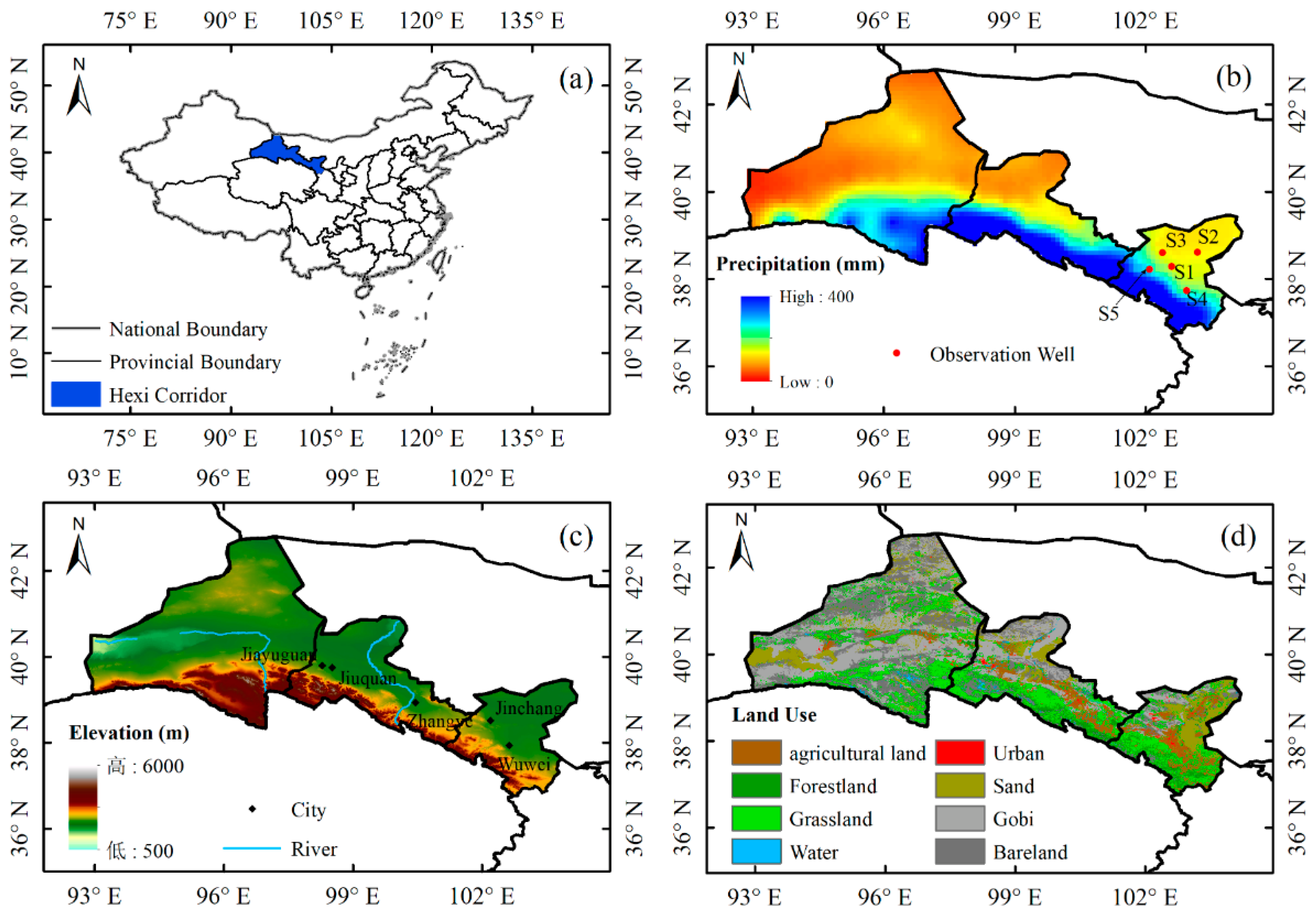



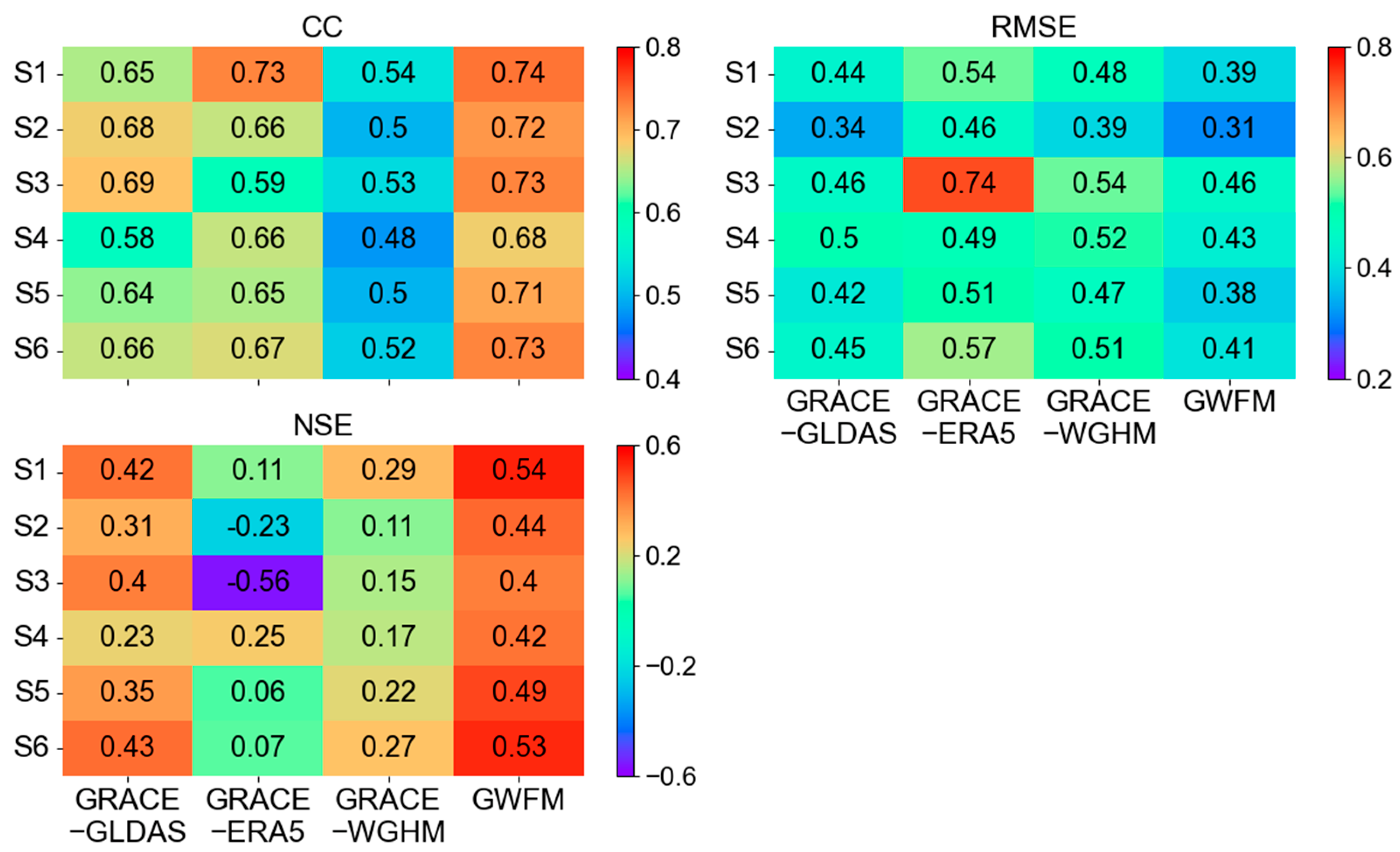
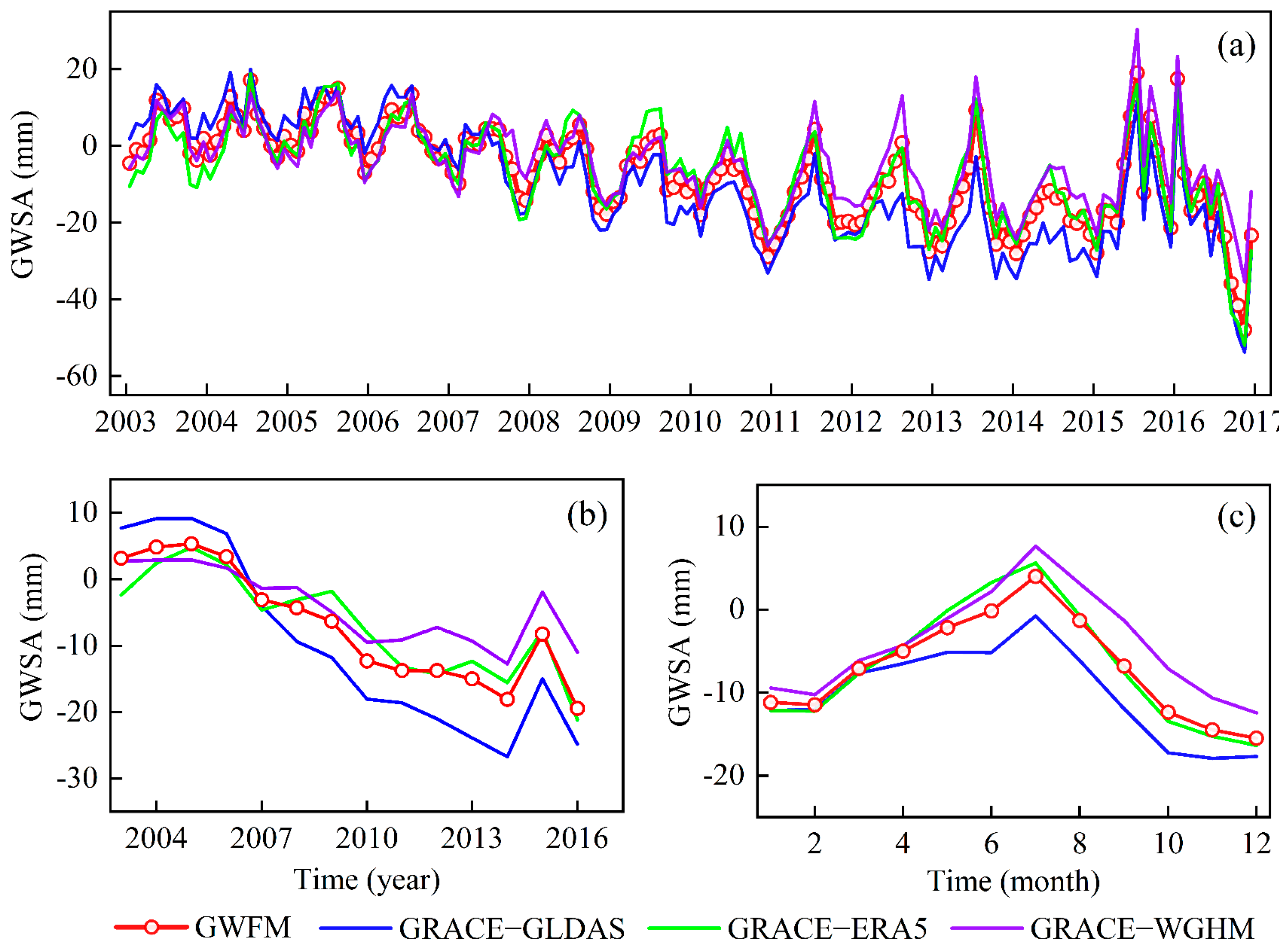
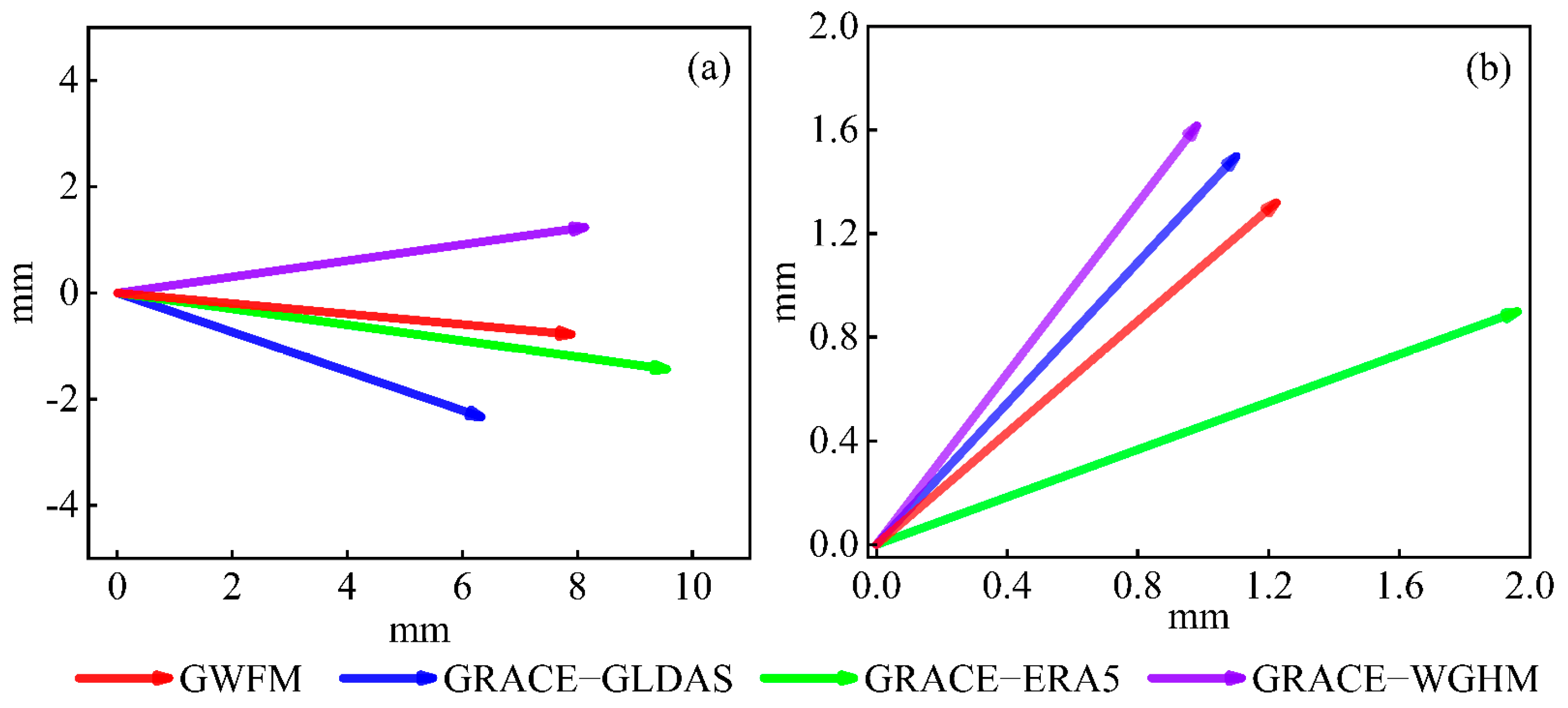
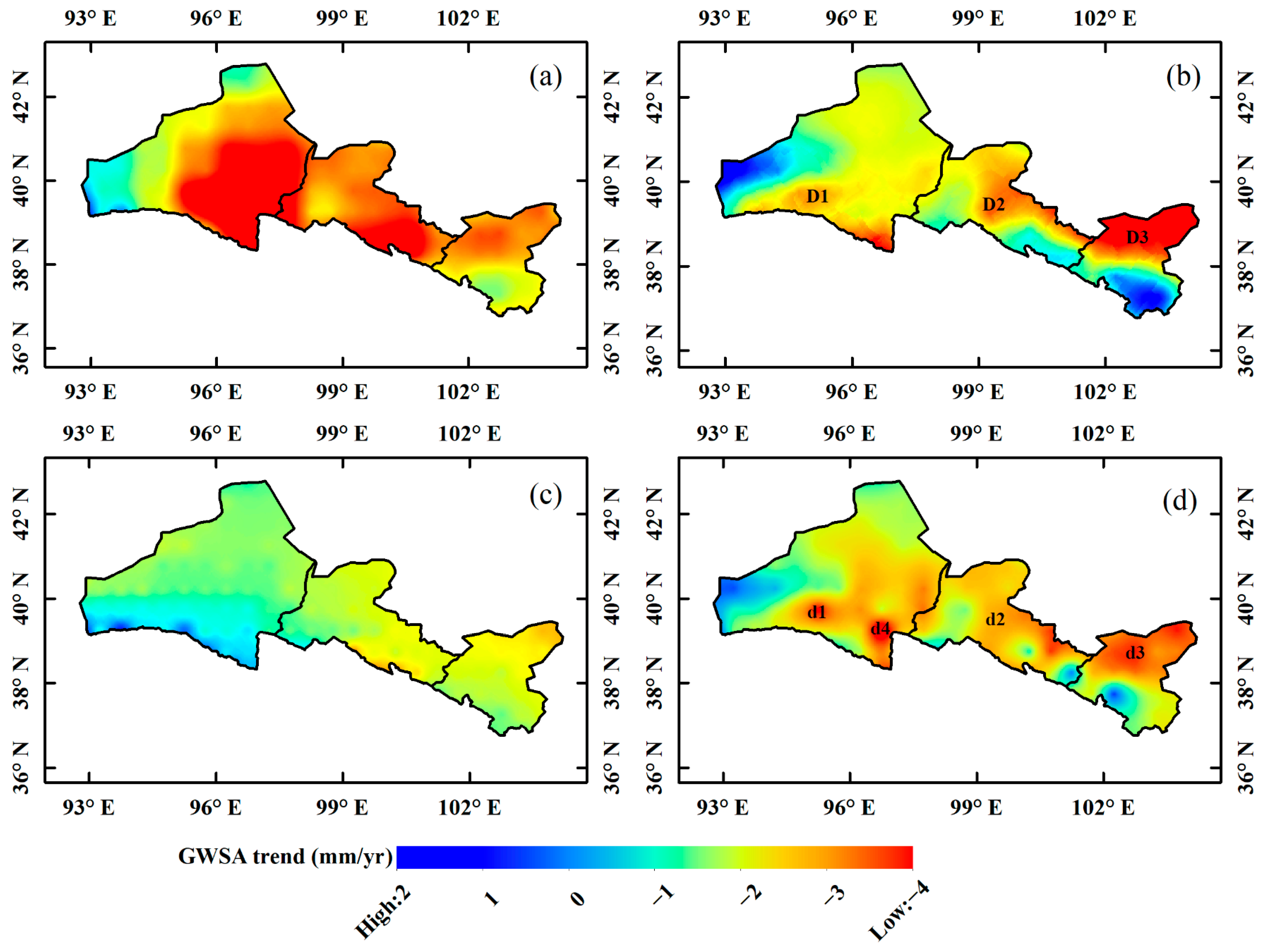



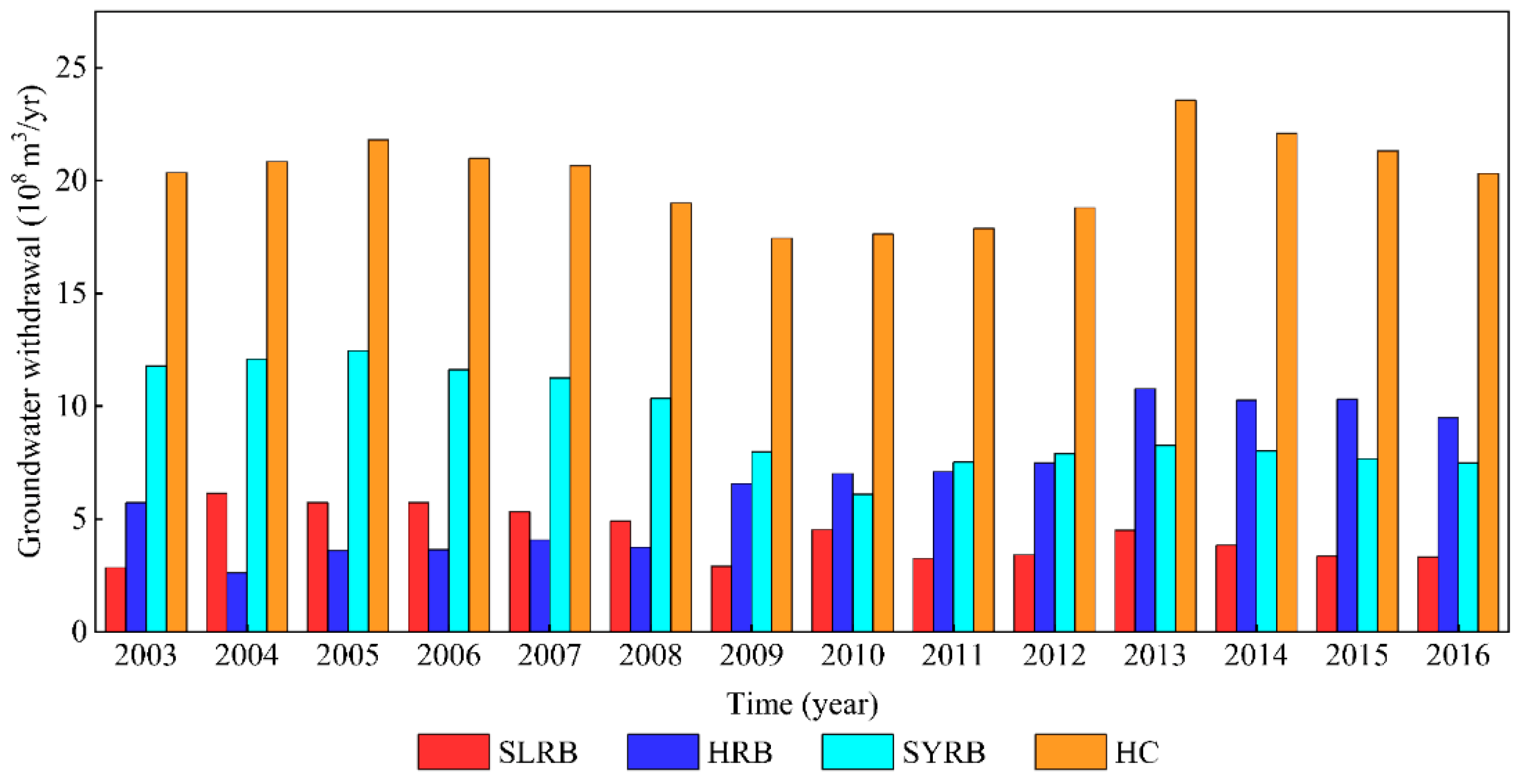
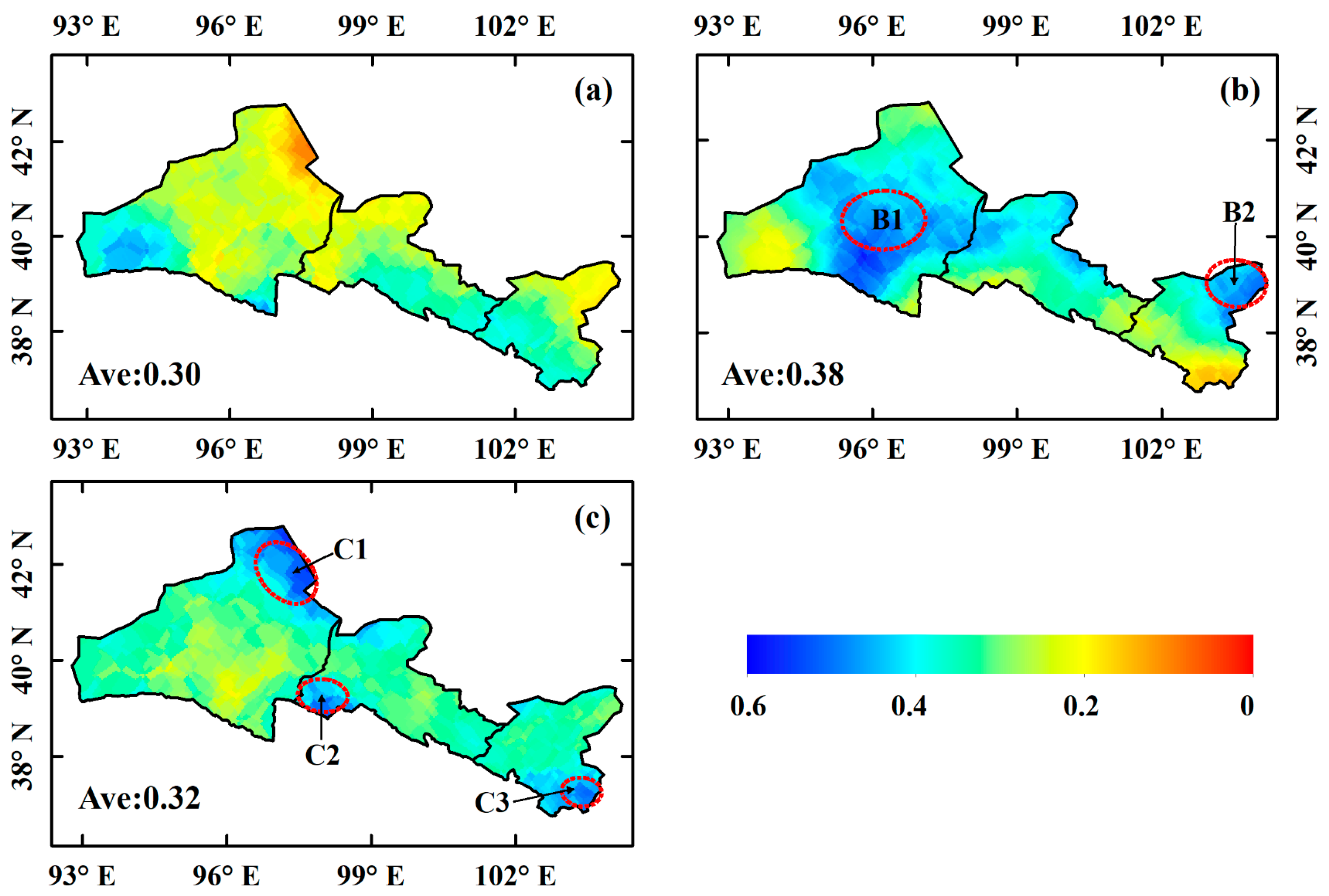
| Datasets | Spatial Resolution | Temporal Resolution | Soil Layer | Depth (cm) |
|---|---|---|---|---|
| GLDAS-Noah | 1.0 × 1.0° | monthly | 4 | 0–10, 10–40, 40–100, 100–200 |
| WGHM | 0.5 × 0.5° | monthly | - | 100–200 |
| ERA5-Land | 0.1 × 0.1° | monthly | 4 | 0–7, 7–28, 28–100, 100–289 |
| Wells | Time Lag (Month) | ||||||
|---|---|---|---|---|---|---|---|
| 0 | 1 | 2 | 3 | 4 | 5 | 6 | |
| S1 | 0.34 | 0.41 | 0.51 | 0.60 | 0.65 | 0.63 | 0.55 |
| S2 | 0.31 | 0.38 | 0.51 | 0.61 | 0.68 | 0.72 | 0.70 |
| S3 | 0.59 | 0.60 | 0.64 | 0.66 | 0.69 | 0.67 | 0.62 |
| S4 | 0.48 | 0.49 | 0.52 | 0.54 | 0.58 | 0.59 | 0.57 |
| S5 | 0.51 | 0.53 | 0.58 | 0.62 | 0.64 | 0.61 | 0.56 |
| Datasets | 2003–2010 | 2011–2016 | ||
|---|---|---|---|---|
| Annual Amplitude (mm) | Trend (mm/yr) | Annual Amplitude (mm) | Trend (mm/yr) | |
| GRACE−GLDAS | 6.59 ± 1.54 | −4.17 ± 0.47 | 7.07 ± 3.34 | −0.48 ± 1.38 |
| GRACE−ERA5 | 9.44 ± 1.42 | −1.08 ± 0.44 | 10.10 ± 3.37 | −0.70 ± 1.39 |
| GRACE−WGHM | 7.12 ± 1.16 | −1.67 ± 0.36 | 9.72 ± 3.20 | 0.07 ± 1.32 |
| GWFM | 7.40 ± 1.22 | −2.37 ± 0.38 | 8.67 ± 3.26 | −0.46 ± 1.35 |
| HC | SLRB | HRB | SYRB | |||||
|---|---|---|---|---|---|---|---|---|
| ηC | ηH | ηC | ηH | ηC | ηH | ηC | ηH | |
| 2003 | 53.73 | −46.27 | 81.23 | −18.77 | 37.28 | −62.72 | 47.37 | −52.63 |
| 2004 | 51.86 | −48.14 | 27.78 | −72.22 | 63.97 | −36.03 | 71.66 | −28.34 |
| 2005 | −15.23 | −84.77 | −69.58 | −30.42 | −88.34 | −11.66 | −70.40 | −29.60 |
| 2006 | 63.40 | −36.60 | 75.86 | −24.14 | 84.24 | −15.76 | 73.67 | −26.33 |
| 2007 | −40.64 | −59.36 | −85.64 | −14.36 | −90.70 | −9.30 | −42.28 | −57.72 |
| 2008 | 32.43 | −67.57 | −38.21 | −61.79 | 12.85 | −87.15 | −58.48 | −41.52 |
| 2009 | 65.73 | −34.27 | 74.17 | −25.83 | 81.21 | −18.79 | 84.84 | −15.16 |
| 2010 | −61.61 | −38.39 | −87.49 | −12.51 | −87.27 | −12.73 | −90.15 | −9.85 |
| 2011 | 70.55 | −29.45 | 90.63 | −9.37 | 84.20 | −15.80 | 71.01 | −28.99 |
| 2012 | −11.98 | −88.02 | −88.78 | −11.22 | 15.48 | −84.52 | −39.99 | −60.01 |
| 2013 | 56.40 | −43.60 | 62.68 | −37.32 | 54.32 | −45.68 | 80.03 | −19.97 |
| 2014 | 55.33 | −44.67 | 78.58 | −21.42 | 46.74 | −53.26 | 47.75 | −52.25 |
| 2015 | 54.91 | −45.09 | 78.35 | −21.65 | 64.81 | −35.19 | −30.96 | −69.04 |
| 2016 | 42.46 | −57.54 | −14.58 | −85.42 | 8.81 | −91.19 | 15.24 | −84.76 |
Publisher’s Note: MDPI stays neutral with regard to jurisdictional claims in published maps and institutional affiliations. |
© 2022 by the authors. Licensee MDPI, Basel, Switzerland. This article is an open access article distributed under the terms and conditions of the Creative Commons Attribution (CC BY) license (https://creativecommons.org/licenses/by/4.0/).
Share and Cite
Su, K.; Zheng, W.; Yin, W.; Hu, L.; Shen, Y. Improving the Accuracy of Groundwater Storage Estimates Based on Groundwater Weighted Fusion Model. Remote Sens. 2022, 14, 202. https://doi.org/10.3390/rs14010202
Su K, Zheng W, Yin W, Hu L, Shen Y. Improving the Accuracy of Groundwater Storage Estimates Based on Groundwater Weighted Fusion Model. Remote Sensing. 2022; 14(1):202. https://doi.org/10.3390/rs14010202
Chicago/Turabian StyleSu, Kai, Wei Zheng, Wenjie Yin, Litang Hu, and Yifan Shen. 2022. "Improving the Accuracy of Groundwater Storage Estimates Based on Groundwater Weighted Fusion Model" Remote Sensing 14, no. 1: 202. https://doi.org/10.3390/rs14010202
APA StyleSu, K., Zheng, W., Yin, W., Hu, L., & Shen, Y. (2022). Improving the Accuracy of Groundwater Storage Estimates Based on Groundwater Weighted Fusion Model. Remote Sensing, 14(1), 202. https://doi.org/10.3390/rs14010202







